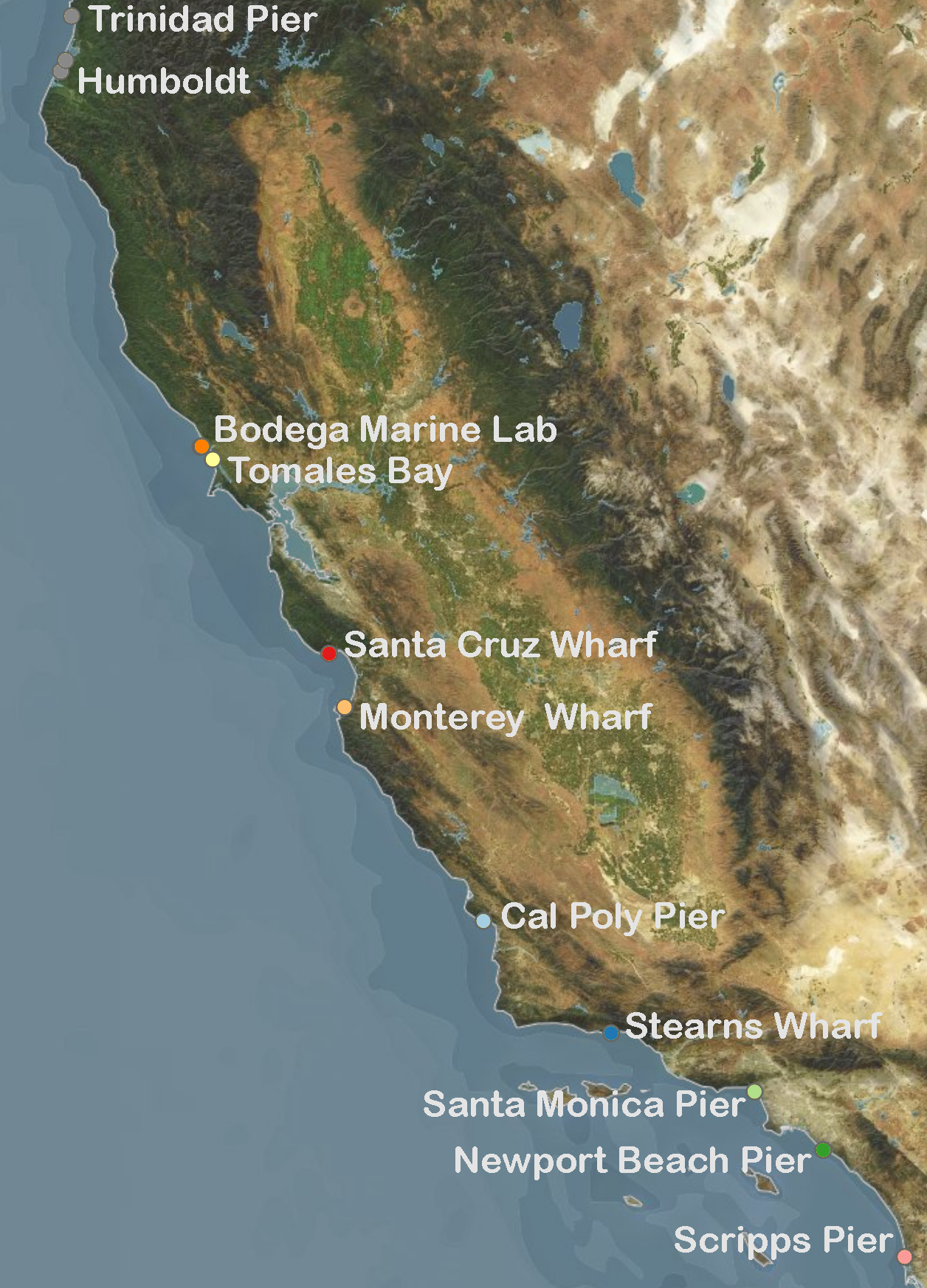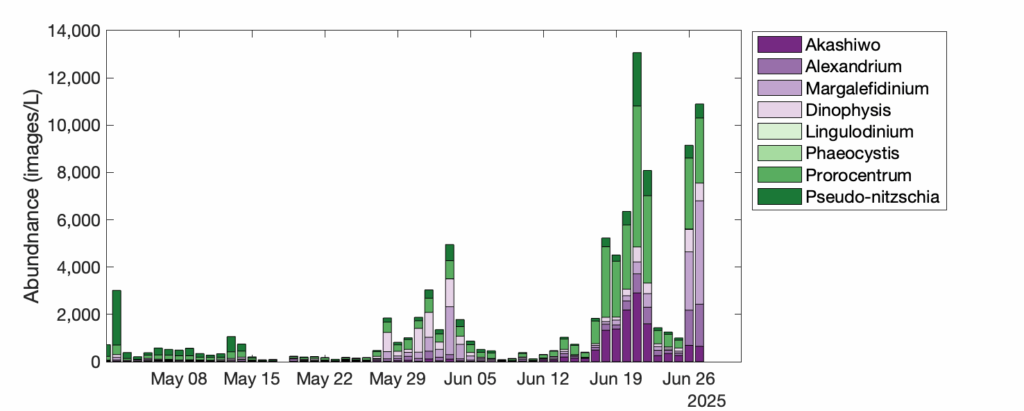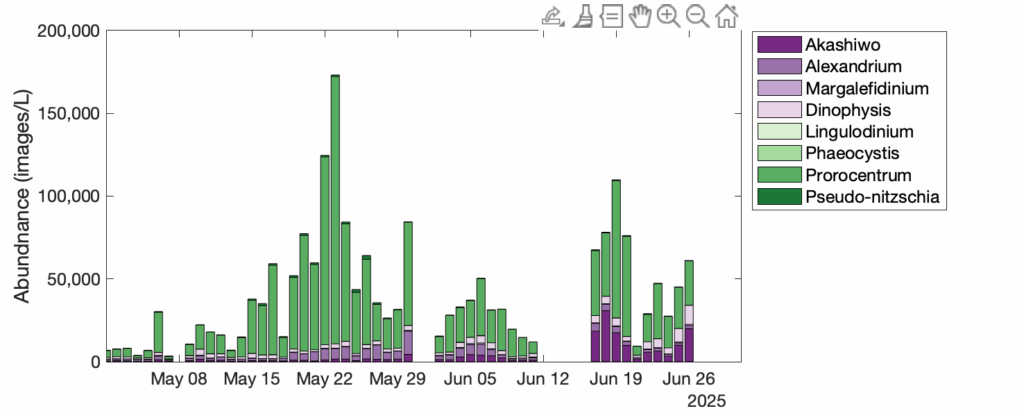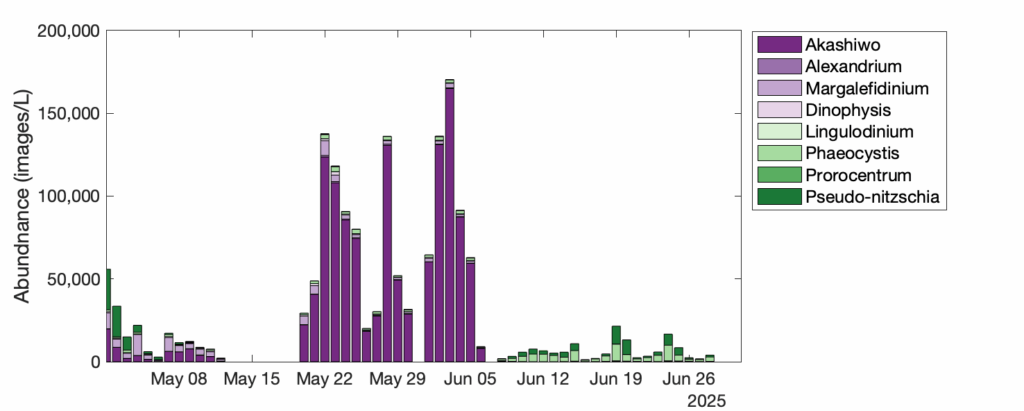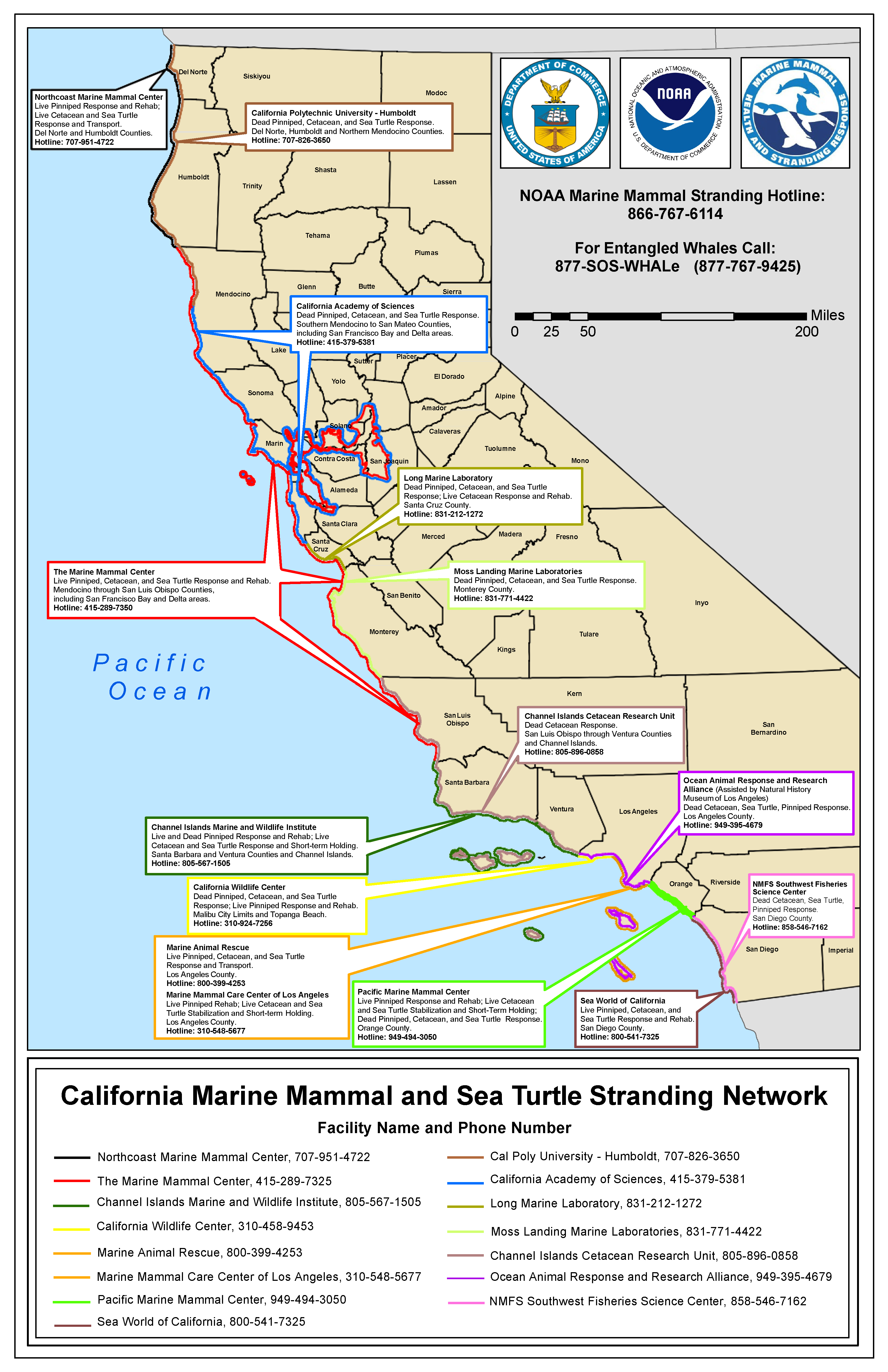May - June 2025
Summary written by Dr. Kasia Kenitz & Dr. Clarissa Anderson on July 17, 2025
- SUMMARY: May and June marked the slow demise of the domoic acid (DA) event across Southern and Central California as the Pacific Ocean shifted from La Niña to El Niño-Southern Oscillation (ENSO) neutral conditions, with a slight warming in the California Current relative to previous months. The toxic bloom persisted in Central California through May but appears to have cleared from all coastal monitoring sites by the end of the month. DA-suspected strandings of California sea lions and dolphins declined from nearly 850 animals reported in April to just over 300 in May, with virtually no DA-related strandings reported in June. Interestingly, an unusual DA advisory for both commercial and recreationally harvested sardines was issued as the bloom was declining, suggesting a build up of DA in the food web that lagged bloom termination. The advisory has now been lifted, and the HAB community has since shifted to one dominated by Akashiwo and Prorocentrum for much of the Southern and Central California coast throughout May and June. Dense Akashiwo blooms in the Santa Barbara Channel (mid-March to early June) are suspected to have caused potentially HAB-related illness symptoms in humans, including inhalation and skin irritation, following contact with marine waters in Ventura County, as reported to state health officials and by local media. Animal tissue and environmental data from the almost three-month long DA event continue to be analyzed as we try to understand patterns and trends.
- C-HARM model predictions continue to flag the entire California coast as high risk for toxic Pseudo-nitzschia spp. bloom development, although with patches of much lower bloom probability emerging along the coastline and in the Southern California Bight. Particulate DA (pDA) predictions from C-HARM were similar to those of Pseudo-nizschia spp. blooms, albeit with many episodes of near zero probability for pDA events in hotspots like the Santa Barbara Channel, central coastline, Monterey Bay and North Coast, less so in the Southern California Bight proper. Cellular DA (cDA) event predictions from C-HARM were similar to those of pDA events, but with even longer periods of near-zero probability of a cDA event in the same known hotspots and near-zero probabilities for much of the Bight. Overall probabilities of cDA decreased rapidly in June, especially in the Bight, where most of the animal strandings occurred during the spring mortality event.
- Marine Mammal Strandings decreased rapidly in May in general agreement with C-HARM and nearshore sampling records of DA activity. There were slight upticks in CA sea lion strandings in central California with relatively larger decreases in marine mammal strandings moving south in May, culminating in a 20-fold drop in stranding numbers by June.
- Weekly HABMAP sampling of phytoplankton confirms that following peak bloom activity of the toxigenic Pseudo-nitzschia “seriata” size class in March and April, the toxic Pseudo-nitzschia bloom disappeared from southern California sites in May. The last positive hit for DA at southern California sites was May 5th. The bloom persisted longer in cooler Central California waters, with peak concentrations of 149,000 cells/L recorded at Santa Cruz on May 21 accompanied by fairly high particulate DA levels. Elevated abundances were also observed at Cal Poly Pier (49,000 cells/L) and Monterey Wharf (40,000 cells/L) throughout May. At Cal Poly Pier, Pseudo-nitzschia remained elevated into June (30,000 cells/L), with a positive hit of pDA at the end of May, but eventually declined by mid June. The toxic bloom was followed by a bloom of the less toxigenic Pseudo-nitzschia “delicatissima” group at Scripps Pier in June, with peak abudnances exceeding 170,000 cells/L on June 2.
- The Imaging Flow Cytobots (IFCBs) – robotic microscopes recording hourly observations – at the same piers and on two moorings out on the shelf largely corroborate HABMAP observations and provide a more detailed image of HAB community shifts. According to the IFCB data, the Pseudo-nitzschia spp. bloom had largely dissipated by early May. A short-lived uptick was observed at Stearns Wharf in mid-June, reaching 40,000 images/L. Elsewhere – Scripps Pier, Santa Cruz, MBARI Power Buoy, and Bodega – IFCB counts remained under 10,000 images/L. In Central California, Santa Cruz and the MBARI Power Buoy recorded extensive Prorocentrum spp. blooms throughout May and June, peaking at over 150,000 cells/L at the Santa Cruz coastal station and 50,000 cells/L offshore. Southern California sites (Scripps Pier and Stearns Wharf) saw significant Akashiwo spp. blooms, with counts exceeding 50,000 cells/L at Scripps in early June and 100,000 cells/L at Stearns Wharf through May and early June. Alexandrium spp. were very rare at all sites except Bodega Bay in the IFCB time series, indicating a waning of the saxitoxin (Parallytic Sellfish Poisoning- PSP) event that co-occurred with the DA event this spring.
- California Department of Public Health conducts its own phytoplankton monitoring and shellfish and seafood testing for PSP toxins and domoic acid. Pseudo-nitzschia “seriata” cells were “Common” at sites in Los Angeles, Santa Cruz, and San Mateo in May but became largely absent or rare by June at all sites except in San Luis Obispo where it was recorded as “Present.” CDPH reported a significant decline in DA and PSP toxin levels in mussel tissue starting in May. PSP toxin levels exceeded alert thresholds only in Santa Barbara until May 11 (123–153 µg/100g). A short-lived PSP spike was detected in Santa Cruz on May 28 (115 µg/100g), following an increase in Alexandrium. In June, elevated PSP levels were recorded in Northern California (Marin and Del Norte), while toxin levels in Central and Southern California remained below alert thresholds. These changes are roughly consistent with HABMAP but do not directly capture the ongoing nearshore “seriata” abundances in central California into June.
- Currently, mussel harvesting alerts are in place for Del Norte, Marin, Santa Cruz, Santa Barbara, Ventura, Los Angeles, and Orange counties, where the public is advised not to consume sport-harvested mussels, clams, scallops, or oysters. In addition, a statewide mussel quarantine is in effect annually from May 1 through October 31. In early May, the California Department of Fish and Wildlife (CDFW), at the recommendation of OEHHA in consultation with CDPH, implemented fishery restrictions for Pacific sardine in waters off the Southern California Bight due to elevated levels of domoic acid detected in the tissue, indicative of remaining food web lags associated with the DA event, despite the fact that phytoplankton populations were already shifting towards bloom termination. These restrictions were lifted on June 13 after tissue toxin levels fell below federal action levels.
Particulate Domoic Acid
Particulate domoic acid (pDA) is the measurement of total domoic acid toxin that is potentially extant in a given area. This forecast provides a probability for where that concentration of toxin is predicted to exceed the threshold that classifies a Harmful Algal Bloom (> 500 nanograms per liter).
The C-HARM v4 model generates nowcast and forecasts of the probability of Pseudo-nitzschia concentrations of in excess of 10,000 cells/L, the probability of particulate domoic acid > 500 nanograms/L, and the probability of cellular domoic acid > 10 picograms/cell in California and Southern Oregon coastal waters. Inputs for the model include near real-time satellite observations, gap-filled chlorophyll a, 486nm reflectance, and 551nm reflectance fields from the S-NPP NOAA VIIRS sensor plus nowcast and forecast data of surface salinity, sea surface temperature, and surface currents from WCOFS ROMS.
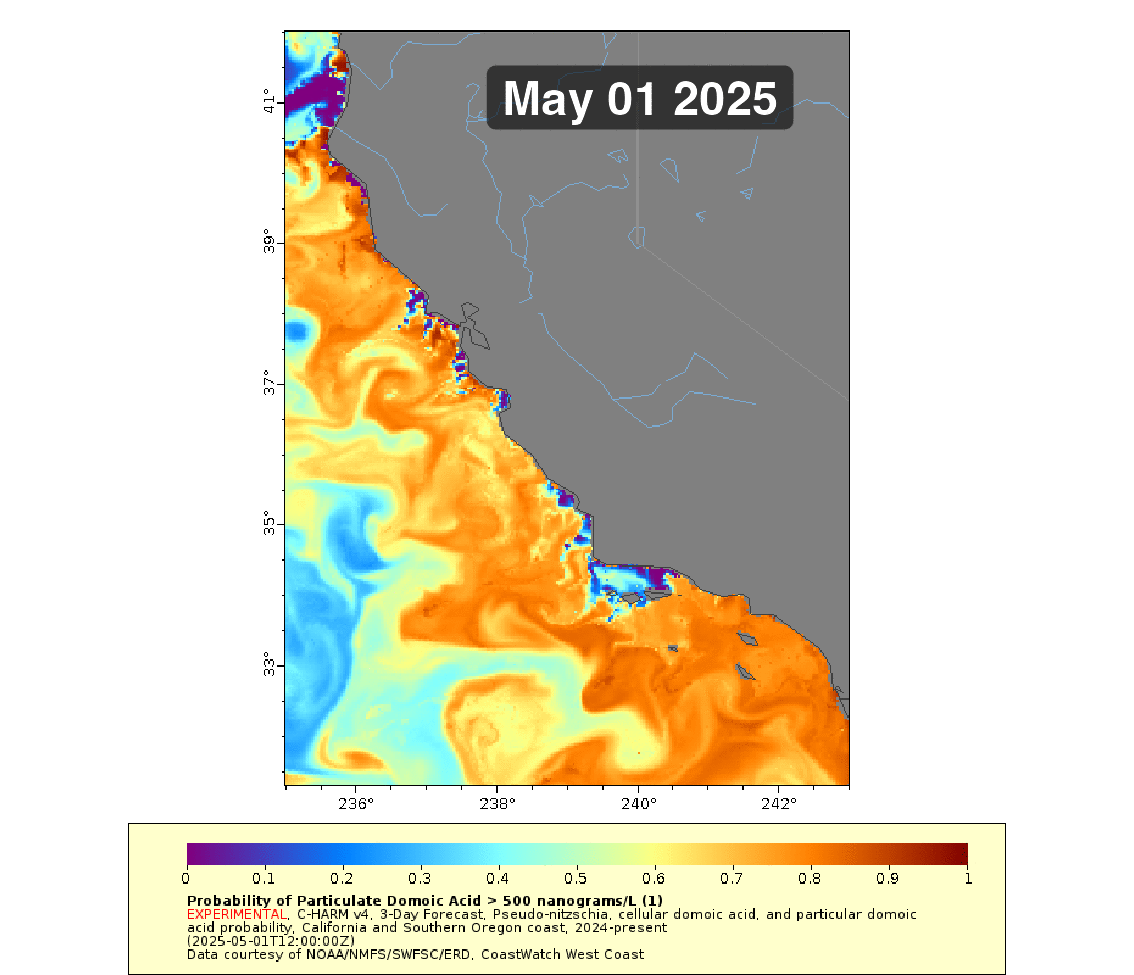
Cellular Domoic Acid
Cellular domoic acid (cDA) is the measure of total domoic acid toxin calculated per cell of Pseudo-nitzschia. This forecast provides a probability for where those cells are expected to be producing toxin at high levels (> 10 picograms per cell).
The C-HARM v4 model generates nowcast and forecasts of the probability of Pseudo-nitzschia concentrations of in excess of 10,000 cells/L, the probability of particulate domoic acid > 500 nanograms/L, and the probability of cellular domoic acid > 10 picograms/cell in California and Southern Oregon coastal waters. Inputs for the model include near real-time satellite observations, gap-filled chlorophyll a, 486nm reflectance, and 551nm reflectance fields from the S-NPP NOAA VIIRS sensor plus nowcast and forecast data of surface salinity, sea surface temperature, and surface currents from WCOFS ROMS.
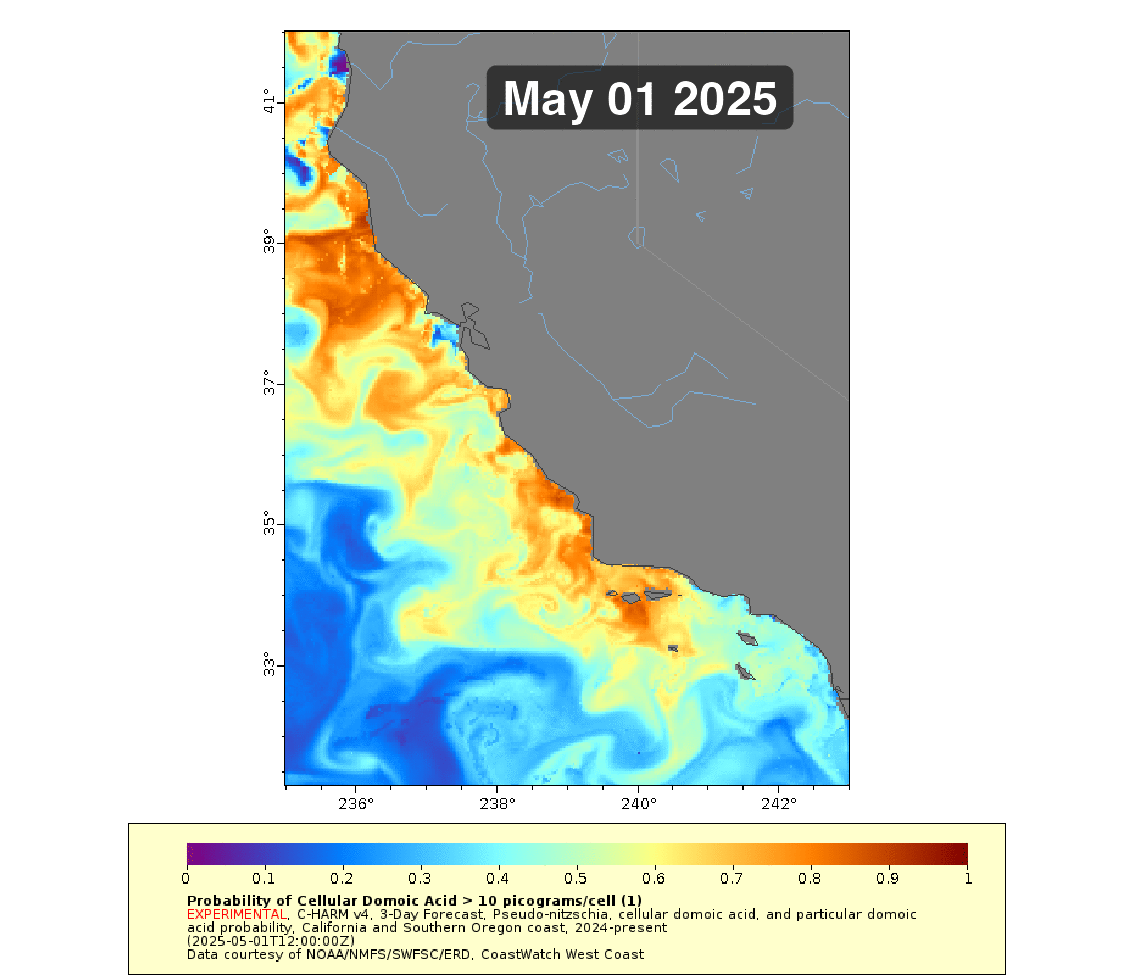
Pseudo-nitzschia
Pseudo-nitzschia is a neurotoxin producing diatom that is observed along the California Coast. Blooms of this phytoplankton can be detrimental to surrounding marine ecosystems. This forecast provides a probability for where the concentration of cells in the water exceed the threshold of a Harmful Algal Bloom ( > 10,000 cells/L).
The C-HARM v4 model generates nowcast and forecasts of the probability of Pseudo-nitzschia concentrations of in excess of 10,000 cells/L, the probability of particulate domoic acid > 500 nanograms/L, and the probability of cellular domoic acid > 10 picograms/cell in California and Southern Oregon coastal waters. Inputs for the model include near real-time satellite observations, gap-filled chlorophyll a, 486nm reflectance, and 551nm reflectance fields from the S-NPP NOAA VIIRS sensor plus nowcast and forecast data of surface salinity, sea surface temperature, and surface currents from WCOFS ROMS.
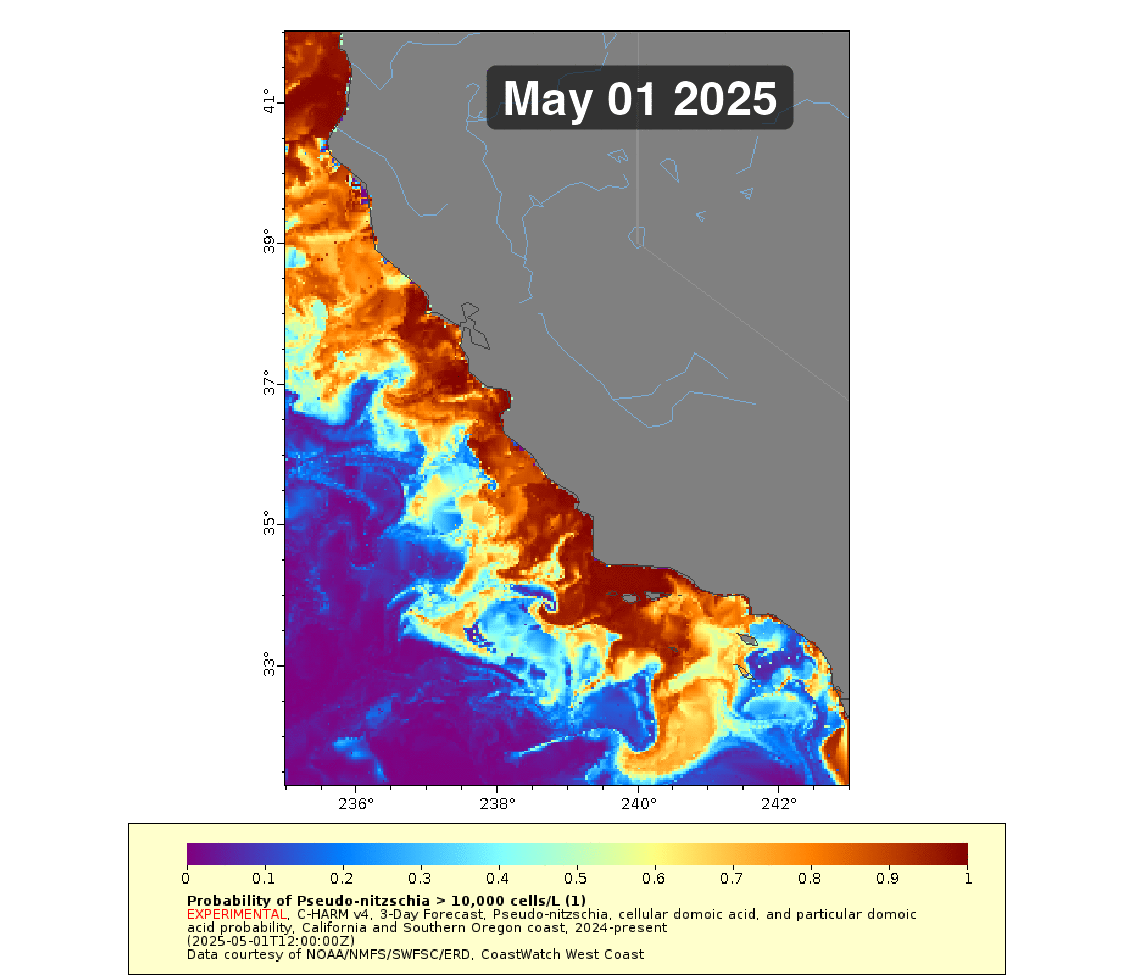
California Harmful Algal Bloom Monitoring & Alert Program
Differentiating Pseudo-nitzschia species by light microscopy is difficult. For this reason, Pseudo-nitzschia “seriata” does not refer to an actual species but rather the larger size class of Pseudo-nitzschia, which is generally a more toxigenic group of species. Alternatively, Pseudo-nitzschia “delicatissima” refers to the smaller size class that is generally non-toxigenic. The dashed line on the plots demarcates the 10,000 cells/L “bloom” threshold designated here for Pseudo-nitzschia populations only.
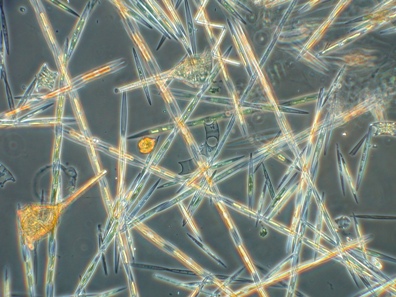
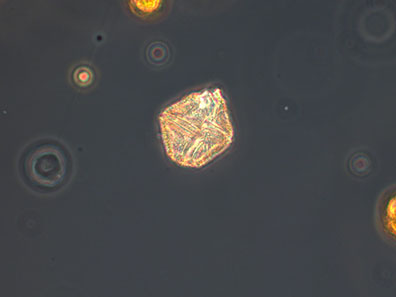
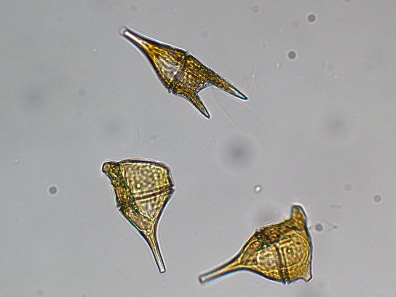
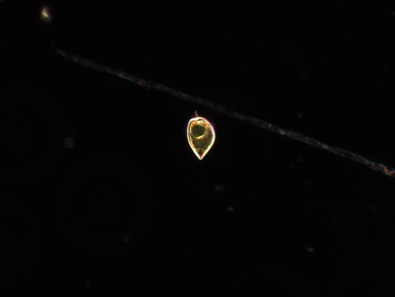
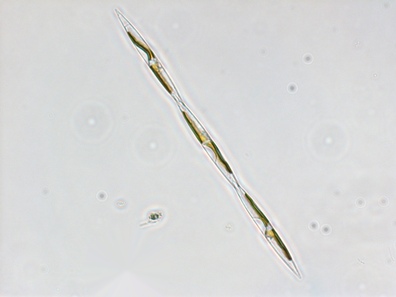
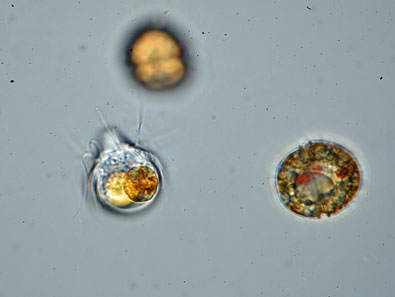
These time series focus on data collected through the scope of this bulletin and the 12 month period that precedes it. Explore the variables and regions that make up the CalHABMAP collective dataset using the plot controls.
More information and data visualizations on the statewide HAB network and forecasting system is found on the California HABMAP website and on the SCCOOS Harmful Algal Bloom page.
A network of Imaging FlowCytobots (IFCBs) continuously photographs particles, such as plankton, in the water. Using machine learning, plankton species can be automatically identified. This will help improve the ability to detect and respond to Harmful Algal Blooms, including the ability to assess conditions that may lead to toxin production or blooms of toxin-producing algae.
These data, coupled with the image classification algorithms developed in collaboration with SCCOOS and CeNCOOS, allow for estimates of species composition over time. The time series below depict sampling outcomes across several California sites. Support provided by NOAA IOOS and CA OPC.
Additional images and data are available on the IFCB dashboard.
Each month, water samples are collected by volunteers and sent to the California Department of Public Health (CDPH) for analysis.
Pseudo-nitzschia ‘seriata’
Alexandrium spp.
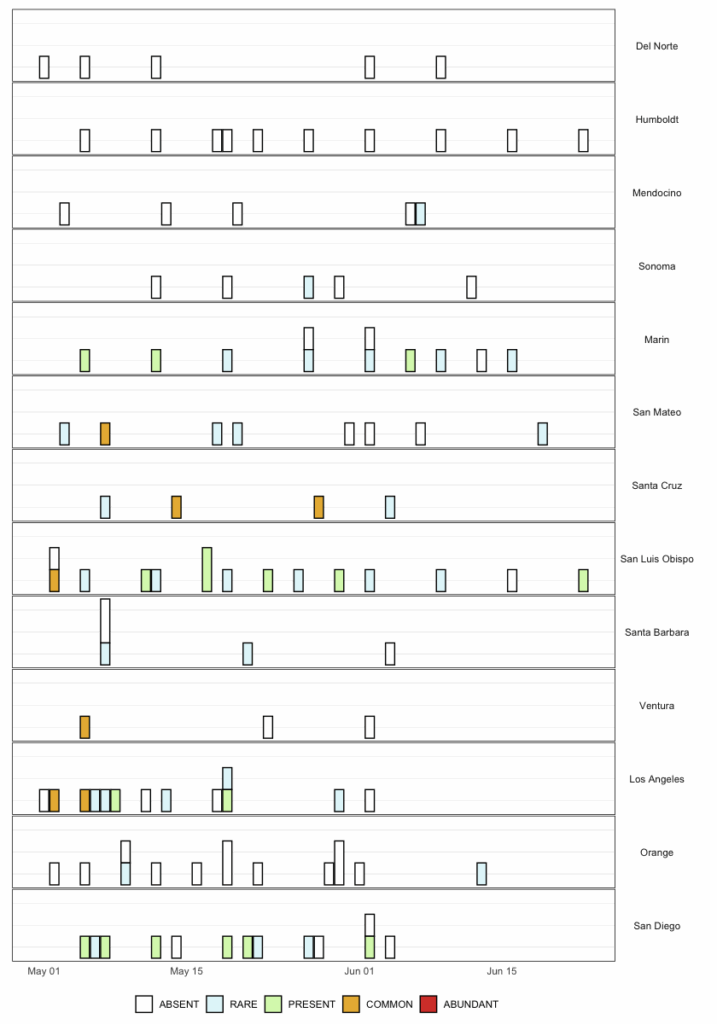
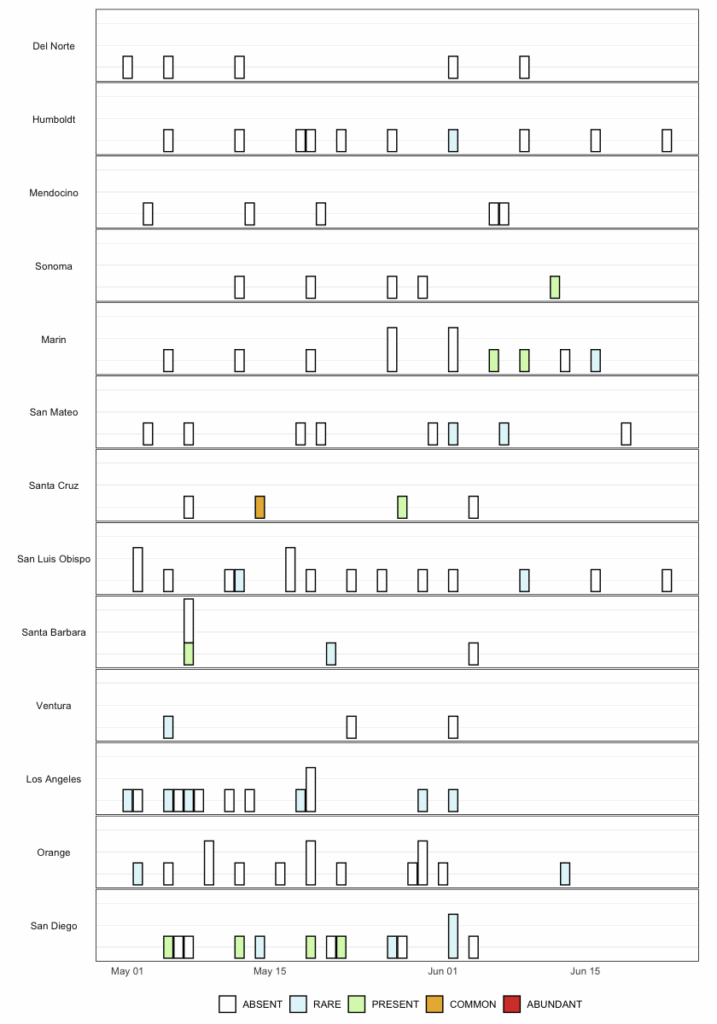
The relative abundance of DA-producing Pseudo-nitzschia ‘seriata’ size class (left) and PSP toxin-producing Alexandrium spp. (right) are catalogued from sample locations within each county. Each bar represents a sample outcome.
____
CDPH is warning distributors and retailers not to sell specific lot numbers of Sea Wave brand frozen anchovies distributed by Cal Marine Fish Company because they contain dangerous levels of domoic acid.
____
CDPH is warning consumers not to eat Pacific sardines caught in Southern California waters from Point Conception in Santa Barbara to the California/Mexico border. Dangerous levels of domoic acid have been detected in Pacific sardines caught in these waters.
____
CDPH has lifted two shellfish safety notifications related to sport-harvested scallops, clams, and oysters from San Diego County.
____
CDPH warns consumers not to eat recreationally harvested mussels, clams, scallops or oysters from Santa Cruz County due to dangerous levels of paralytic shellfish poisoning (PSP) toxins detected.
____
CDPH has lifted a previous warning about Pacific sardines harvested from Southern California waters. Recent laboratory results show domoic acid in Pacific sardines from these waters have declined to safe levels.
____
CDPH warns consumers not to eat recreationally harvested mussels, clams, scallops or oysters from Marin County due to dangerous levels of paralytic shellfish poisoning (PSP) toxins detected.
Water Sample Detailed Data
| Date_Sampled | County | Sample_Site | PN_Percent_Comp | PN_Density | AL_Percent_Comp | AL_Density |
|---|---|---|---|---|---|---|
| 2025-02-17 | San Diego | Oceanside Harbor | 70 | ABUNDANT | 0 | ABSENT |
| 2025-02-13 | San Diego | San Diego Bay, U.S. Navy Pier | 45 | COMMON | 0 | ABSENT |
| 2025-02-18 | San Diego | La Jolla, Scripps Pier | 45 | COMMON | 0 | ABSENT |
| 2025-02-24 | Los Angeles | Manhattan Beach Pier | 45 | COMMON | 0 | ABSENT |
| 2025-02-14 | Orange | Dana Pt. Harbor | 30 | COMMON | 0 | ABSENT |
| 2025-02-07 | Orange | Bolsa Chica | 25 | COMMON | 0 | ABSENT |
| 2025-02-23 | Los Angeles | Catalina Island, OFFSHORE | 25 | COMMON | 0 | ABSENT |
| 2025-02-18 | Los Angeles | Palos Verdes Rocky Pt Offshore | 10 | COMMON | 0 | ABSENT |
| 2025-01-27 | San Diego | La Jolla, Scripps Pier | 10 | COMMON | 0 | ABSENT |
| 2025-02-05 | San Diego | Imperial Beach Pier | 10 | COMMON | 0 | ABSENT |
| 2025-02-19 | San Diego | San Diego Harbor, Pier 159 | 9 | PRESENT | 0 | ABSENT |
| 2025-01-31 | Orange | Bolsa Chica | 8 | PRESENT | 0 | ABSENT |
| 2025-02-10 | Marin | Tomales Bay, Lease #M430-15 | 5 | PRESENT | 0 | ABSENT |
| 2025-02-03 | San Diego | La Jolla, Scripps Pier | 5 | PRESENT | 1 | PRESENT |
| 2025-02-15 | Los Angeles | Catalina Island, Avalon Bay | 5 | PRESENT | 0 | ABSENT |
| 2025-02-21 | Santa Barbara | Santa Barbara Ch., Naples Pt | 5 | PRESENT | 6 | PRESENT |
| 2025-02-11 | Santa Barbara | Goleta Pier | 4 | PRESENT | 0 | ABSENT |
| 2025-02-10 | Mendocino | Mendocino, Noyo Harbor | 3 | PRESENT | 0 | ABSENT |
| 2025-02-26 | San Diego | Imperial Beach Pier | 3 | PRESENT | 0 | ABSENT |
| 2025-01-27 | Ventura | Ventura, Port Hueneme Pier | 2 | PRESENT | 0 | ABSENT |
| 2025-02-05 | Orange | San Clemente Pier | 2 | PRESENT | 0 | ABSENT |
| 2025-02-26 | Orange | San Clemente Pier | 2 | PRESENT | 0 | ABSENT |
| 2025-01-29 | San Diego | San Diego Bay, U.S. Navy Pier | 1.5 | PRESENT | 0.5 | RARE |
| 2025-01-29 | San Luis Obispo | San Luis Obispo, Cal Poly Pier | 1 | PRESENT | 0 | ABSENT |
| 2025-02-28 | San Diego | San Diego Bay, U.S. Navy Pier | 1 | PRESENT | 0.5 | RARE |
| 2025-02-03 | San Luis Obispo | Morro Bay, Boat Launch | 0.5 | RARE | 0 | ABSENT |
| 2025-02-03 | Marin | Tomales Bay, Lease #M430-15 | 0.5 | RARE | 0 | ABSENT |
| 2025-01-29 | Santa Barbara | Goleta Pier | 0.5 | RARE | 0.5 | RARE |
| 2025-02-10 | San Luis Obispo | Morro Bay, Boat Launch | 0.5 | RARE | 0 | ABSENT |
| 2025-02-17 | San Luis Obispo | Morro Bay, Boat Launch | 0.5 | RARE | 0 | ABSENT |
| 2025-02-10 | San Diego | La Jolla, Scripps Pier | 0.5 | RARE | 0 | ABSENT |
| 2025-02-24 | Marin | Tomales Bay, Lease #M430-15 | 0.5 | RARE | 0 | ABSENT |
| 2025-02-14 | Orange | Bolsa Chica | 0.5 | RARE | 0 | ABSENT |
| 2025-01-27 | Marin | Tomales Bay, Lease #M430-15 | 0 | ABSENT | 0 | ABSENT |
| 2025-01-27 | San Luis Obispo | Morro Bay, Boat Launch | 0 | ABSENT | 0 | ABSENT |
| 2025-01-27 | Humboldt | Humboldt Bay, Indian Is. Ch. | 0 | ABSENT | 0 | ABSENT |
| 2025-01-29 | Santa Barbara | Santa Barbara, Stearns Wharf | 0 | ABSENT | 0 | ABSENT |
| 2025-01-29 | Santa Cruz | Santa Cruz Wharf | 0 | ABSENT | 0 | ABSENT |
| 2025-02-03 | Humboldt | Humboldt Bay, Indian Is. Ch. | 0 | ABSENT | 0 | ABSENT |
| 2025-01-27 | Del Norte | Hunter Rock, north | 0 | ABSENT | 0 | ABSENT |
| 2025-02-10 | Humboldt | Humboldt Bay, Indian Is. Ch. | 0 | ABSENT | 0 | ABSENT |
| 2025-02-12 | Humboldt | Trinidad Pier | 0 | ABSENT | 0 | ABSENT |
| 2025-02-12 | Santa Cruz | Santa Cruz Wharf | 0 | ABSENT | 0 | ABSENT |
| 2025-02-18 | Humboldt | Humboldt Bay, Indian Is. Ch. | 0 | ABSENT | 0 | ABSENT |
| 2025-02-17 | Marin | Tomales Bay, Lease #M430-15 | 0 | ABSENT | 0 | ABSENT |
| 2025-01-30 | Orange | Newport Bay, Back Bay | 0 | ABSENT | 0 | ABSENT |
| 2025-01-28 | Del Norte | Wilson Creek | 0 | ABSENT | 0 | ABSENT |
| 2025-01-30 | Mendocino | Mendocino, Noyo Harbor | 0 | ABSENT | 0 | ABSENT |
| 2025-01-30 | Mendocino | Mendocino, Noyo OFFSHORE | 0 | ABSENT | 0 | ABSENT |
| 2025-02-06 | Del Norte | Wilson Creek | 0 | ABSENT | 0 | ABSENT |
| 2025-02-10 | Mendocino | Point Arena Pier | 0 | ABSENT | 0 | ABSENT |
| 2025-02-11 | Del Norte | Wilson Creek | 0 | ABSENT | 0 | ABSENT |
| 2025-02-04 | Orange | Newport Bay, Back Bay | 0 | ABSENT | 0 | ABSENT |
| 2025-02-28 | Marin | Richmond, Marina Bay Harbor | 0 | ABSENT | 0 | ABSENT |
| 2025-02-05 | Santa Cruz | Santa Cruz Wharf | 0 | ABSENT | 0 | ABSENT |
| 2025-02-24 | Humboldt | Humboldt Bay, Indian Is. Ch. | 0 | ABSENT | 0 | ABSENT |
| 2025-02-24 | San Luis Obispo | Morro Bay, Boat Launch | 0 | ABSENT | 0 | ABSENT |
| 2025-02-04 | Los Angeles | Santa Monica Bay, 3901 | 0 | ABSENT | 0 | ABSENT |
| 2025-02-03 | Orange | Crystal Cove SB, OFFSHORE | 0 | ABSENT | 0 | ABSENT |
| 2025-02-26 | Marin | Drakes Bay, Chimney Rock LBS | 0 | ABSENT | 0 | ABSENT |
| 2025-02-18 | Orange | Newport Bay, Back Bay | 0 | ABSENT | 0 | ABSENT |
| 2025-02-25 | San Mateo | Bean Hollow State Beach | 0 | ABSENT | 0 | ABSENT |
| 2025-02-25 | San Mateo | Pillar Point Harbor | 0 | ABSENT | 0 | ABSENT |
| 2025-02-27 | Del Norte | Hunter Rock, north | 0 | ABSENT | 0 | ABSENT |
| 2025-02-24 | San Diego | La Jolla, Scripps Pier | 0 | ABSENT | 0 | ABSENT |
| 2025-02-24 | Sonoma | Shell Beach, Sea Ranch | 0 | ABSENT | 0 | ABSENT |
| 2025-02-26 | Santa Barbara | Goleta Pier | 0 | ABSENT | 1 | PRESENT |
| 2025-02-28 | San Mateo | Pillar Point Harbor | 0 | ABSENT | 0 | ABSENT |
| 2025-02-17 | Mendocino | Mendocino, Noyo Harbor | 0 | ABSENT | 0 | ABSENT |
| 2025-02-11 | Orange | Newport Bay, Back Bay | 0 | ABSENT | 0 | ABSENT |
| 2025-02-24 | Sonoma | Kashia Coastal Reserve | 0 | ABSENT | 0 | ABSENT |
| 2025-02-27 | Del Norte | Wilson Creek | 0 | ABSENT | 0 | ABSENT |
| 2025-02-21 | Orange | Bolsa Chica | 0 | ABSENT | 0.5 | RARE |
Percent composition categories help us look at phytoplankton trends across an entire region to evaluate risk of biotoxin presence. Many other factors contribute to our evaluation of risk in an area. These samples are posted for informational purposes only. They are not intended to inform the public of the presence or lack of risk. For the latest health advisory information, see the CDPH Health Advisory Map below.

Domoic acid (DA) is a potent neurotoxin produced by some diatom species of the genus Pseudo-nitzschia. Species exposed to DA can result in seizures, epilepsy, cardiomyopathy, and death depending upon the ingested dose. DA toxicosis commonly occurs in California sea lions (Zalophus californianus), presumably due to a combination of foraging behavior and seasonal movements.
The Marine Mammal Center (TMMC), Channel Islands Marine Wildlife Institute (CIMWI), California Wildlife Center (CWC), Marine Mammal Care Center Los Angeles (MMCC-LA), Pacific Marine Mammal Center (PMMC), SeaWorld, and Southwest Fisheries Science Center (SWFSC) act like an emergency room by working to rescue and rehabilitate sick and injured marine mammals, seabirds, and sea turtles.
An overview of this active event and current forecast for domoic acid risk can be explored below.
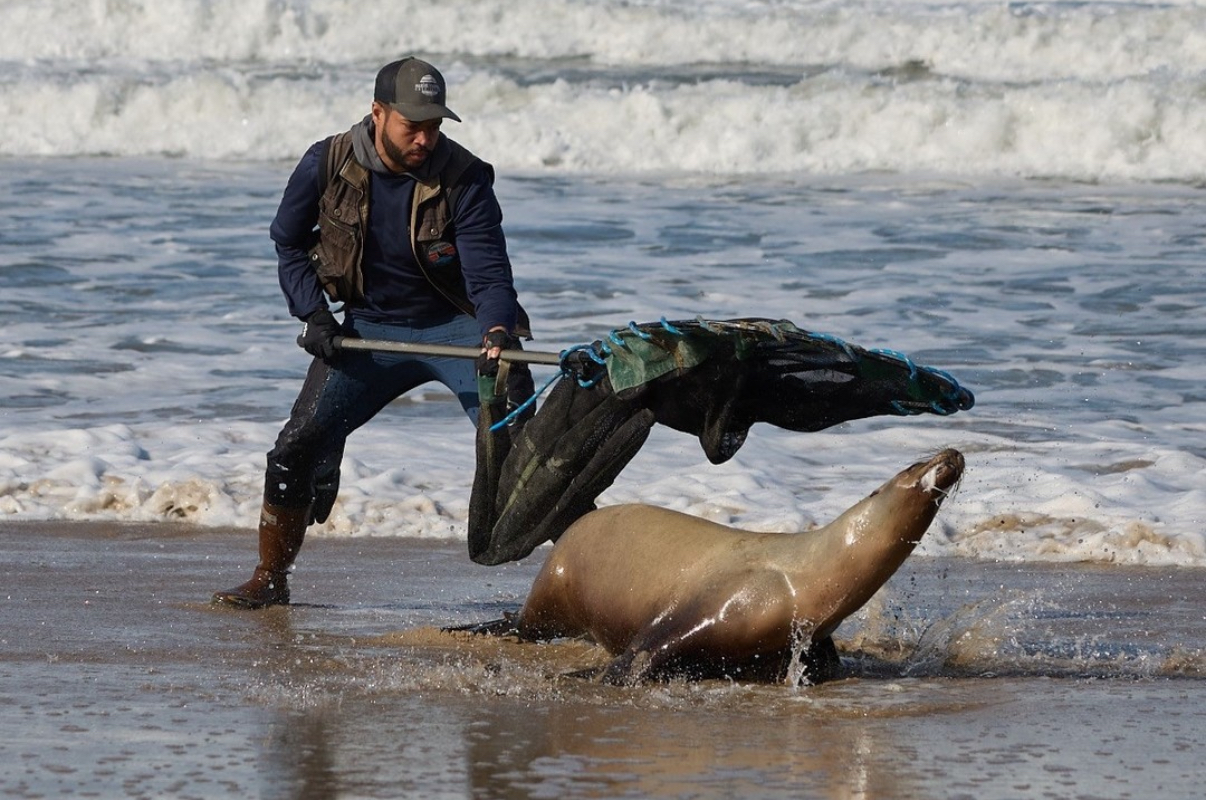
California HAB Bulletin
All data and reports have been synthesized by SCCOOS for the California Harmful Algal Bloom Monthly Bulletin.
Data Access & Resources:
C-HARM, NOAA CoastWatch ERDDAP
Toxic Phytoplankton Observations, CDPH
Imaging FlowCytoBot Dashboard
CalHABMAP Datasets, SCCOOS ERDDAP


